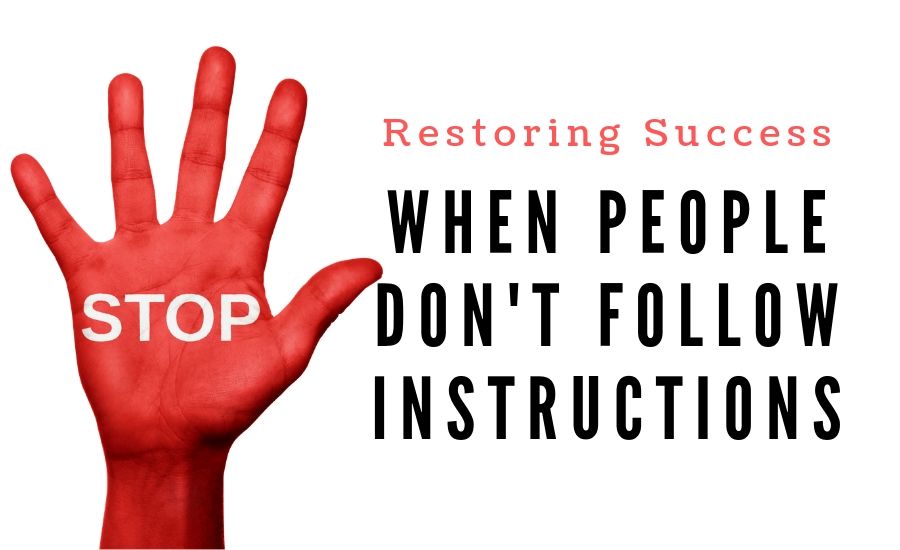One of the root causes of all kinds of problems in our organizations can be traced back to simply not following instructions. It is a common source of frustration for managers and leaders.
As I pondered this phenomenon that can inadvertently have disastrous consequences, I began to reflect on my own behaviors. My nature is to be a “rule follower" and follow the directions of others carefully; however, I realized that I do or have done things that are against the grain of being a good instruction follower.
I like to cook but not bake. Why? Baking requires exact measurements and the following of directions. General cooking allows a lot of room for creativity and freedom; a pinch of this and a pinch of that, so much fun. Is this why some don’t follow instructions? Is there desire to be independent and creative?
I was trying to do something in PowerPoint and although I knew I could get step-by-step instructions and complete my mission efficiently, I fought the notion for 20 minutes. I clicked around, determined to figure it out without instructions. I finally caved, used the robust help feature and got clear step by step instructions on how to complete my objective. WHY did I do this?
Most of us have tried to put a piece of furniture together without the instructions; however, in our organizations, it is a valuable skill to follow instructions and preferably not optional. Instructions in our companies come in many forms: manuals, product labels, safety tags and SDS (Safety Data Sheets), tasks, work orders, signs, verbal, emails, texts, and more. A disregarded instruction or a step missed can lead to a loss of efficiency, compromise the quality of your services, customer experience, and even have safety and hazard-related consequences.
The ability to follow instructions is a skill and can be developed and proactively managed within your organization. Here are a few considerations to help the team develop their abilities to follow instructions:
- Leadership: Have an understanding that this is a competency that may need to be developed. There is an element of human nature at play and there may be a wide range of capabilities. Utilize understanding, information, tools, and training to help develop individuals’ abilities to follow instructions. Also, consider the skills and development of those who give the instructions.
-
Context: Make sure they understand the importance of the different types of instructions. (We are fighting our human nature and propensity to save time.) Consider:
- The last time I got a new car, I did not read the manual. If I get a new expensive piece of equipment, I may be inclined to skip the manual. The result may be damaging the new equipment or worse.
- Work Order/Task: The work order is a list with seven steps and one of them is to bring a ladder; this step is skipped and the result is a job debacle. It is very important to follow every step on the work order or we will fail at delivering on our commitment to our customer.
-
Written Instructions: When delivering written instructions in any format — work orders, tasks, email, or text — be clear, concise, and consistent in delivery. Break down steps with numbers, bullets, check boxes, etc.
- Adapt: Be flexible in your approach to accommodate your team’s individual needs and help them succeed. A more experienced team member may be able to execute with the instructions broken into three steps where a newer team member may need more detail for the same task.
- Encourage your team to ask questions or request clarification for any instructions that they don’t understand.
- Verbal Instructions: Instructions may be delivered at any given point verbally, but this is particularly common when being given direction by customers and those we serve. Strong listening skills are very important to being able to follow verbal instructions. Memories are short; verbal instructions should be recorded/written.
- Training: In our very early years and throughout school, our abilities to follow instructions are being developed and evaluated. These skills can continue to be developed in our workplaces. Be resourceful and incorporate the development of this skill in your company’s training programs.
-
Culture: Like so many things, our organizations’ strengths and weaknesses are found in the roots of our culture.
- Keep it front and center, starting at the top. Consistently incorporate it into the language and movement:
“Our new carpet extractor is here. Let’s read the instructions.”
“I sent you a new task, did you review the instructions yet? Let me know if you have questions.”
“We have a great new product; let’s read the instructions and the SDS.”
- Accountability: Consistently hold members of the team accountable when an instruction is not followed. In performance reviews, evaluate and discuss their ability to follow instructions. Recognize and reward the team for following instructions.
Read more on managing your restoration business
When instructions are not followed, bad things can happen. Find positive approaches to help the team follow instructions.
Happy Restoring Success!


